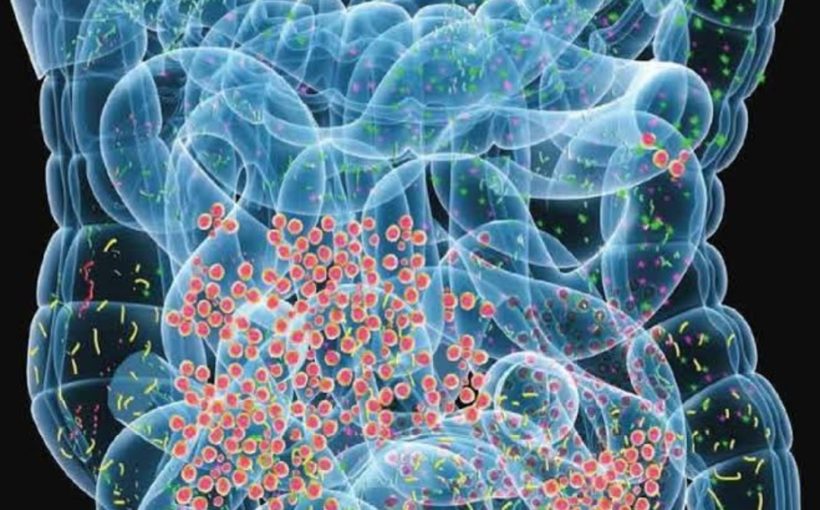The microbes that inhabit our bodies are influenced by what we eat, drink, breathe and absorb through our skin, and most of us are chronically exposed to natural and human-made environmental contaminants. In a new paper, scientists from the University of Illinois at Urbana-Champaign review the research linking dozens of environmental chemicals to changes in the gut microbiome and associated health challenges.
The review is published in the journal Toxicological Sciences.
The paper includes sections on compounds used in manufacturing consumer goods, including the bisphenols found in plastic food packaging, and phthalates, which are used in everything from vinyl flooring to plastic films. It also describes the science associated with exposure to persistent organic pollutants and heavy metals. POPs include chemicals like PCBs; perfluorochemicals, which are used in nonstick cookware and food packaging; flame retardants known as polybrominated diphenyl ethers; and pesticides and herbicides.
“More than 300 environmental contaminants or the metabolic byproducts of those contaminants have been measured in human urine, blood or other biological samples,” said Jodi Flaws, a U. of I. professor of comparative biosciences who led the analysis with Ph.D. student Karen Chiu. “Chemicals such as bisphenols, phthalates and some pesticides, persistent organic pollutants and heavy metals can alter hormone metabolism and are associated with adverse health outcomes.”
The negative health effects linked to these chemicals include reproductive and developmental defects, Type 2 diabetes, cardiovascular dysfunction, liver disease, obesity, thyroid disorders and poor immune function, the researchers report.
Dozens of studies have explored how chemical exposures affect health, and scientists are now turning their attention to how these chemicals influence gut microbes. The studies reviewed in the new paper were conducted in rats, mice, fish, dogs, chickens, cows, human adults and infants, honey bees and other organisms.
Studies have found that exposure to bisphenols, which are detectable in the urine of more than 90% of adults in the United States, increases levels of Methanobrevibacter bacteria in the male gut. These microbes have been shown—in humans and in mice—to boost their host’s ability to extract more energy from food.
“This raises a strong possibility that BPA-induced weight gain is caused at least partially by BPA-induced changes in the gut microbiome,” the researchers wrote.
Phthalates are plasticizers and stabilizers that easily leach into foods. Eating phthalate-contaminated foods is the primary route of exposure in humans. Like bisphenols, phthalates are endocrine disruptors, meaning that they interfere with normal hormone-signaling in the body.
High phthalate exposure in human newborns is associated with changes in the gut microbiome and altered immune responses to vaccination. In mice, exposure to phthalates during puberty appears to inhibit the microbial synthesis of butyrate, a metabolite that is essential for intestinal health, immune regulation and neurological function.
Persistent organic pollutants are oily organic chemicals that can persist in the environment for years or decades.
“Recent studies have investigated the impact of POP exposure on the gut microbiota during developmental, juvenile and adult stages in a variety of animals, including mice, fish and humans,” the researchers wrote.
Studies have found that exposure to PCBs is associated with microbial shifts in the gut and increased gut permeability, intestinal inflammation and cognitive problems. Once used as coolants, PCBs were banned in the U.S. in 1978 but persist in the environment.
Perfluorochemicals are used in nonstick cookware, food packaging and stain-resistant carpets. One study linked PFCs to changes in the gut microbiome and impaired lipid metabolism in female—but not male—fish and their offspring. The microbiome shifts persisted in the offspring, and the young fish suffered higher mortality than those whose mothers were not exposed to PFCs.
Studies have found that exposure to glyphosate herbicides alters the bacterial makeup of the gut microbiome in cattle, rodents and honey bees. It increased anxious and depressive symptoms in the mice and was associated with an increase in pathogenic bacteria in cattle. The pesticide chlorpyrifos affects microbial populations in male rodents and fish exposed during development and adulthood, and also causes inflammation and oxidative stress in the gut.
“All of these data together suggest that exposure to many of these environmental chemicals during various stages of life can alter the gut microbiome in ways that influence health,” Chiu said. “The pathologies associated with altered microbiomes after exposure to environmental chemicals include immune dysfunction, altered carbohydrate and lipid metabolism, and neurological and behavioral impairments. We are also seeing that these effects highly depend on an individual’s sex and age.”
University of Illinois at Urbana-Champaign


